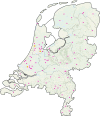Preparations of Dutch emergency departments for the COVID-19 pandemic: A questionnaire-based study
- PMID: 34506521
- PMCID: PMC8432867
- DOI: 10.1371/journal.pone.0256982
Preparations of Dutch emergency departments for the COVID-19 pandemic: A questionnaire-based study
Abstract
Background: The onset of the COVID-19 pandemic was characterized by rapid increases in Emergency department (ED) patient visits. EDs required an appropriate transformation. The main challenges were: adapting capacity to respond to surges in the number of patient visits, protection of high risk (frontline) staff and the segregation of suspect-COVID-19 patients. To date, only a few studies have assessed the nation-wide response of EDs to the COVID-19 pandemic. This study was designed to review the preparations of Dutch EDs during the initial phase of this public health crisis.
Methods: The study was designed as a nation-wide, cross-sectional, questionnaire-based study of Dutch hospital organizations having one or more EDs. One respondent completed the questionnaire for each hospital. The questionnaire was conducted between the first and the second COVID-19 wave in the Netherlands. It contained close-ended and open-ended questions on changes in ED infrastructure, ED workforce adaptions and the role of emergency physicians (EPs) in each hospital crisis management team.
Results: The questionnaire was completed by 58 respondents. This represented 80% of the total number of EDs. All respondents had made preparations in anticipation of a COVID-19 patient surge. Treatment capacity was expanded in 70% of EDs, with a median increase of 49% (IQR 33-73%). Suspect-COVID-19 was segregated from non-COVID-19 patients in 89% of EDs. Alternative locations (such as outpatient departments) were more often used to assess non-COVID-19 patients, than for suspect-COVID-19 patients. Staff was expanded in 82% of EDs. This largely concerned nursing staff. A formal role for Emergency Physicians (EPs) in the hospital's crisis management team was reported by 94% of hospital organizations employing EPs.
Conclusion: All Dutch EDs responded to the COVID-19 pandemic in a very short time span despite much uncertainty. Preparations predominantly concerned expansion of treatment capacity and segregation of COVID-19 ED care. EPs played a prominent role, both in direct COVID-19 care and in the hospital crises management team. It is vital for EDs to adapt to community needs swiftly. The ability of EDs to respond to the pandemic varied considerably.
Conflict of interest statement
The authors have declared that no competing interests exist.
Figures
References
-
- Adhanom Ghebreyesus T. WHO Director-General’s opening remarks at the media briefing on COVID-19. 2020 March 11. [cited: 2021 March 22]. World Health Organization. Available from: https://www.who.int/director-general/speeches/detail/who-director-genera....
-
- Alderweireld CEA, Buiting AGM, Murk JAN, Verweij JJ, Berrevoets MAH, van Kasteren, Marjo E. E. COVID-19: patient zero in the Netherlands. Ned Tijdschr Geneeskd. 2020July2;164. - PubMed
-
- COVID-19 dataset [Internet].: Dutch National Institute for Public Health and the Environment (Rijksinstituut voor Volksgezondheid en Milieu) [Accessed: Mar 25 2021]. Available from: https://data.rivm.nl/covid-19/COVID-19_aantallen_gemeente_cumulatief.csv
MeSH terms
LinkOut - more resources
Full Text Sources
Medical


